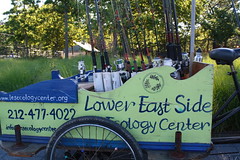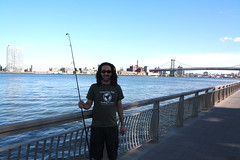On Wednesday, the last day of school, dozens of students hung up their Gone Fishin’ signs – literally. Along the East River esplanade, kids of various ages tried out their angling skills at a fishing clinic hosted by the Lower East Side Ecology Center.
“Our goal with fishing clinics is to get people down here to learn about the river,” said Daniel Tainow, the center’s educational director. “We want to teach people that there are things they can do to help protect the quality of the river.”
While kids threw back anything they hooked, a little further up the river, near the Williamsburg Bridge, it was a different story.
“I eat whatever I catch,” said Wilfredo Castro, one of several East Village residents who lounged by their fishing poles. He fishes on the river almost every day. “The ecosystem is healthy. That’s why the fish like it,” he said.
But the fish may not be as safe as local fishermen would like to think, due to residual pollutants from rampant industrial dumping in the 1970s. Signs along the river caution children under the age of 15 and pregnant women from consuming anything caught there.
“Anglers should be mindful of the general statewide advisory that recommends eating no more than one meal of fish per week from the state’s freshwaters,” said Lori Sevino, a press officer for New York’s Department for Environmental Conservation, in an e-mail.
Captain Chas Stamm, former director of the Hudson River Fisherman’s Association, agreed. He said the East River was the best place to fish in the world, but added that he has always thrown his catch back into its waters. “To be honest with you, catch-and-release is really the sport fisherman’s way to go,” he said. “You renew the resource.”
Mr. Stamm also expressed concerns about the contaminant level in the river’s “edible” fish. New York’s waters are routinely infected by the dangerous pathogens in raw sewage when the city’s sewer system overflows after heavy rains. During a tour of the waterfront in April, Mr. Tainow suggested the installation of marshes as a way to purify the water. The idea has come up during the planning of an East River Blueway.
While rules dictate that only the large fish can be kept, it is often the biggest ones that contain the most contaminants. Because of a process called biomagnification, the concentration of pollutants is amplified on the upper levels of the food chain. So the big striped bass and bluefish reeled in on the East River are often the most affected.
Captain Don Grippo, who has run a charter boat out of New York’s surrounding waters for 15 years, argued that because the fish are migratory, they don’t stay in one place long enough to be seriously contaminated. “Most of my clients eat them,” he said. “They are the same fish you’re going to catch a month prior in Montauk.”
Back on the East River Esplanade, the focus was on the fun of fishing rather than health concerns. One young fisherman squealed that he had caught a fish.
Looking closer, he found that his line was snagged on a pipe running underneath the murky water.







